Pricing Strategies for Luxury Fashion Brands: A Useful Handbook for Starting Designers
In the world of luxury fashion, setting prices is a delicate art that requires careful consideration of multiple factors. Luxury brands aim to sustain their business while effectively communicating the unique value of their products to retain a loyal customer base.
### Quality of Garments
The quality of luxury fashion items is paramount. Brands focus on using high-quality materials and employing exceptional craftsmanship, which justifies the premium pricing of their products. Items crafted from the finest materials and with intricate designs are typically priced higher due to their superior quality[3].
Exclusivity and limited editions also play a significant role in pricing. Prices increase for rare or limited-edition items due to their scarcity and the prestige associated with owning them[3].
### Brand Positioning
Established luxury brands leverage their reputation and heritage to maintain high prices. The brand's history and prestige contribute to the perceived value of the product[4]. Brands use marketing strategies that emphasize the exclusivity, craftsmanship, and quality of their products to position themselves as elite[4].
### Emotional Experience
Luxury brands create an emotional experience by offering bespoke services, personalized customer interactions, and exclusive events. This enhances the perceived value beyond the physical product[4]. Brands also craft compelling narratives about their history, craftsmanship, and design ethos to create an emotional connection with customers, which can increase willingness to pay a premium[4].
### Pricing Strategies
Tiered pricing is a common strategy used by luxury brands to cater to different segments of their audience. Offering entry-level products allows them to attract a wider audience while maintaining high-end exclusivity[3]. Brands also justify higher prices by emphasizing the value proposition, such as durability, sustainability, and the status symbol associated with owning luxury goods[1][4].
### Communicating Value
Luxury brands use high-end marketing and advertising campaigns to highlight the quality, craftsmanship, and exclusivity of their products, reinforcing their luxury status[2]. Increasingly, luxury brands are focusing on sustainability and transparency to appeal to environmentally conscious consumers, further enhancing the perceived value of their products[2].
Balancing these factors is crucial to avoid common pricing mistakes such as undervaluing one's work, ignoring market expectations, and pricing without understanding customer psychology. In the luxury market, perceived value plays a major role; a high price signals status, exclusivity, and the fact that the product is worth investing in.
Planning for sales, exclusives, and capsule drops can help maintain the luxury image of a brand while also funding production and rewarding loyal customers. By considering these key factors, luxury fashion brands can price their products in a way that reflects their quality, brand positioning, and the emotional experience they aim to provide.
- In the luxury fashion industry, brands communicate the unique value of their apparel and accessories by leveraging quality materials, exceptional craftsmanship, and marketing strategies that emphasize exclusivity, craftsmanship, and quality, thereby positioning them as elite within the fashion-and-beauty business.
- To cater to various segments of the audience, luxury brands employ tiered pricing strategies, offering entry-level products to attract a wider audience while maintaining high-end exclusivity, and justifying higher prices through durability, sustainability, and the status symbol associated with owning luxury goods.
- Alongside physical product quality, luxury brands create an emotional experience for customers through bespoke services, personalized interactions, and exclusive events, which reinforces the perceived value of the personal-finance investment.
- In the competitive fashion-and-beauty industry, luxury brands must balance various pricing factors, such as the quality of garments, brand positioning, emotional experience, and the need to sustain their business, to ensure a price that accurately reflects the value and prestige associated with their lifestyle brand and products.




